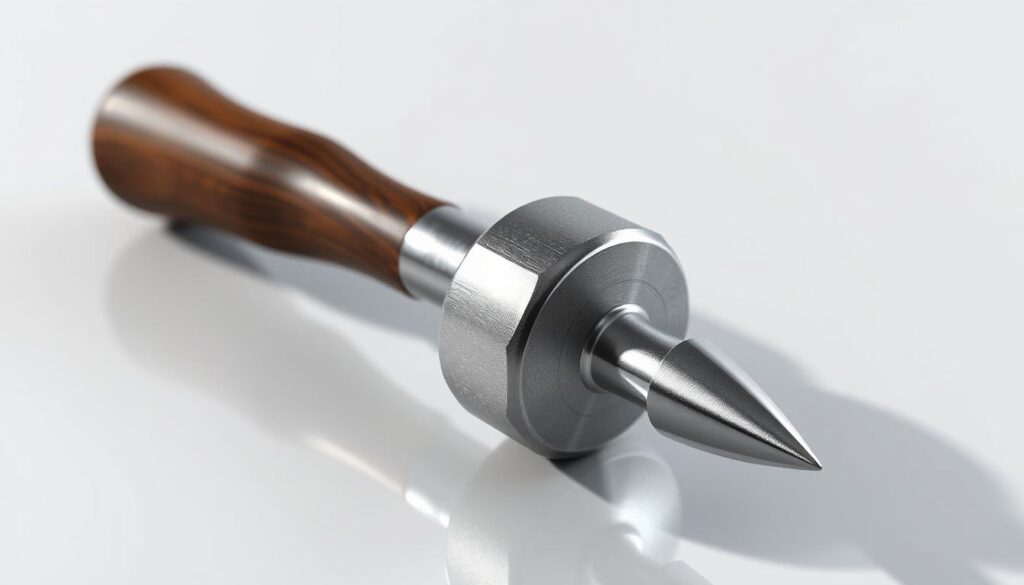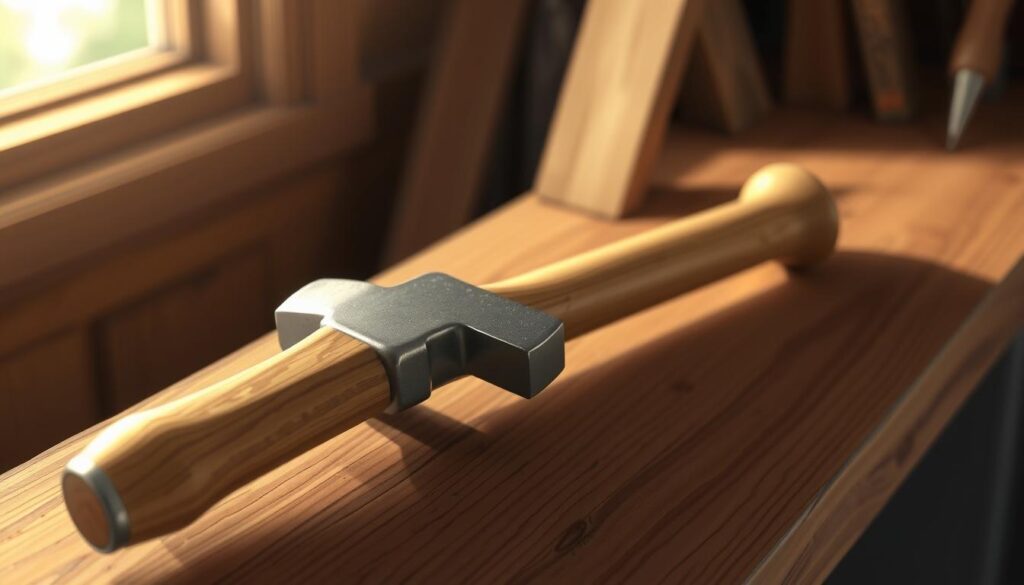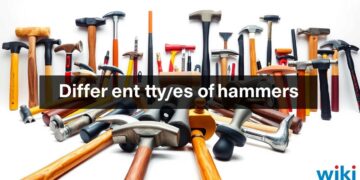Did you know the right hammer can make or break a project? DIY and construction tasks are many. From simple repairs to big projects, knowing your hammers is key for success and safety.
Hammers are basic tools with many types. Each is made for a specific job. Whether it’s hanging a picture or building a house, the right hammer matters a lot.
Exploring hammers shows choosing the right one is more than a personal choice. It’s about picking the best tool for the task. This guide will help you pick the right hammer for your next project.
Key Takeaways
- Understanding the various hammer types is essential for DIY and construction projects.
- The right hammer can significantly impact the efficiency and safety of your work.
- Different tasks require different hammers, from simple repairs to complex constructions.
- Choosing the correct hammer involves considering the specific needs of your project.
- A well-informed choice of hammer can improve the quality of your work.
1. Claw Hammer: The Classic Choice for Home Projects
The claw hammer is a versatile tool found in many homes and construction sites. It’s not just a hammer; it’s also a nail puller. This makes it very useful for many tasks.
Uses and Benefits
A claw hammer is great for driving nails into wood. Its curved claw is also good for pulling nails out. It’s perfect for carpentry, repairs, and furniture assembly.
You can use it for hanging pictures or building a deck. Having a claw hammer saves you from buying separate tools for driving and pulling nails. It’s versatile, easy to use, and very handy.
For more information on hammers and their uses, check out this resource.
Key Features
When picking a claw hammer, consider its weight and handle material. Claw hammers weigh between 16 to 20 ounces, with 16 ounces being common. The handle can be wood, steel, or fiberglass.
Fiberglass handles absorb shock better than wood. The hammer’s balance is also key. A balanced hammer helps you drive nails more accurately.
Choosing the Right Size
The right size claw hammer depends on the task. For most home projects, a 16-ounce hammer is enough. But for heavier tasks, a 20-ounce hammer might be better.
Think about the projects you’ll do most. For framing or demolition, a heavier hammer is better. For lighter tasks, a lighter hammer is fine.
Knowing about claw hammers helps you choose the right one for your toolbox. Whether you DIY or are a pro, a claw hammer is a tool you’ll use a lot.
2. Sledgehammer: Power for Heavy-Duty Tasks
A sledgehammer is the best tool for jobs that need a lot of strength. It’s great for tearing down walls, breaking concrete, and driving stakes. Its long handle helps you use your body’s power to do these tough jobs.
Common Applications
Sledgehammers are very useful in many ways. They’re often used for:
- Demolition projects to break down walls and structures
- Construction sites to drive stakes or break up existing concrete
- Landscaping to remove rocks or break up hard soil
These hammers are essential for any project that requires significant force. They’re a must-have for both professionals and DIYers.
Variations in Weight
Sledgehammers vary in weight, from 2 to 20 pounds (1 to 9 kg). The weight you choose depends on the job and how strong you are. Lighter hammers are better for smaller tasks or for using a long time. Heavier ones are for jobs that need more power.
Think about how heavy you want your sledgehammer to be. A heavier hammer might be better for some jobs. But, it also needs more strength and control to use safely.
Safety Precautions
It’s very important to use a sledgehammer safely to avoid getting hurt. Here are some safety tips:
- Always wear protective gear, including safety glasses and gloves
- Ensure a firm grip on the handle to maintain control
- Keep your work area clear of debris and obstacles
- Be mindful of your surroundings to avoid accidents
Caution is key when wielding a sledgehammer. Its power can cause accidents if not used carefully.
3. Framing Hammer: Built for Construction
A framing hammer is key for any construction job. It makes framing work easier. It has special features that set it apart from other hammers, making it a must-have for builders.
Design Differences
Framing hammers have heavy heads and straight claws. These are perfect for big nails and pulling them out. The serrated face stops the hammer from slipping off nails, ensuring a solid hit every time.
Advantages for Framing
Framing hammers are great for framing because of their design. They are heavy and balanced, giving the right amount of force for nails. The straight claws also help pull nails out without harming the wood.
Recommended Brands
Many brands make top-notch framing hammers. Here are some of the best:
| Brand | Model | Notable Features |
|---|---|---|
| Estwing | E3-16C | Curved claw, shock-reducing grip |
| Vaughan & Sons | 23500 | Straight claw, milled face |
| Titan | TCGHC1 | Fiberglass handle, magnetic nail starter |
When picking a framing hammer, think about its weight, balance, and claw type. The right hammer can really improve your work’s efficiency and quality.
4. Ball Peen Hammer: For Metalwork and More
The ball peen hammer is key for metalwork and more. It’s great because it can do two things at once. This makes it a must-have in many workshops.
Unique Features
The ball peen hammer has a dual-ended design. One end is flat, and the other is rounded. This lets you do lots of things, like hammering and shaping metal.
The flat side is perfect for driving nails or fitting things together. The ball peen side is for shaping metal, closing rivets, and hitting punches. It’s a tool that does it all.
Typical Uses in Workshops
In metalwork, the ball peen hammer is used for many tasks. Here are a few:
- Shaping and forming metal
- Closing rivets
- Striking punches and chisels
It’s not just for metalwork. It’s also good for carpentry and DIY projects. This makes it a multipurpose tool in many places.

Maintenance Tips
To keep your ball peen hammer in good shape, you need to take care of it. Here’s how:
| Maintenance Task | Frequency | Benefit |
|---|---|---|
| Inspect for damage | Before each use | Prevents accidents |
| Clean the hammer | After each use | Removes debris |
| Store properly | After use | Protects the handle |
By following these tips, your ball peen hammer will last longer. It will stay a reliable tool in your workshop.
5. Rubber Mallet: Gentle but Effective
A rubber mallet is key for tasks needing a soft touch. It’s better than metal hammers for jobs where you don’t want to damage surfaces.
When to Use a Rubber Mallet
Use a rubber mallet when you need to tap things into place gently. It’s great for putting furniture together or setting tiles without harming them.
Common uses for a rubber mallet include:
- Assembling furniture
- Positioning tiles or flooring
- Tapping out dents in metalwork
- Adjusting machinery parts
Material Considerations
The quality of a rubber mallet depends on its material. Look for ones made from tough, resilient rubber. Some also have soft handles for better grip.
For example, a rubber mallet with a harder rubber head might be more suitable for tasks that require a bit more force, while a softer rubber head is better for delicate surfaces.
Advantages Over Metal Hammers
Rubber mallets are safer than metal hammers because they don’t damage surfaces as much. They’re perfect for finish work or when you’re working with materials that easily get dented or scratched.
| Feature | Rubber Mallet | Metal Hammer |
|---|---|---|
| Surface Protection | Reduces risk of damage | May cause dents or scratches |
| Impact Force | Soft, gentle impact | Hard, forceful impact |
| Typical Use Cases | Furniture assembly, tile positioning | Driving nails, demolition |
A seasoned carpenter says, “A rubber mallet is essential for any DIY or professional. It’s perfect for delicate tasks, adding value to your toolkit.”
“A good rubber mallet can make all the difference in the quality of your work, especially when working with sensitive materials.”
6. Dead Blow Hammer: Reducing Rebound
A dead blow hammer is made to cut down on rebound. It gives a controlled strike force for many uses.
Mechanism Explained
The dead blow hammer’s design is special. Its head is filled with sand or steel shot. This absorbs shock when you hit it, stopping rebound.
This design lets you strike more precisely. The shock is absorbed, so the hammer doesn’t bounce back. This is great for tasks needing precision.
Best Use Cases
Dead blow hammers are great for tasks needing precision and control. This includes automotive repair and woodworking. They help avoid damage to nearby materials.
In car repair, they help tap parts into place safely. In woodworking, they drive dowels or tap joints without harming the wood.
Pros and Cons
Dead blow hammers have good points and bad. They offer control and precision, perfect for delicate work. But, they cost more than regular hammers. Their use must be correct to work well.
| Pros | Cons |
|---|---|
| High precision and control | Generally more expensive |
| Ideal for delicate tasks | Effectiveness depends on proper use |
| Reduces damage to surrounding material | Limited to specific applications |
Looking to buy a dead blow hammer? Check out Trusty Cook. They have many options for different needs.
7. Tack Hammer: Small but Mighty
Whether you’re a seasoned craftsman or a DIY enthusiast, the tack hammer is a valuable addition to your toolkit. Tack hammers are designed for precision and are used for delicate tasks that require a gentle touch. They are often magnetized, making it easier to drive small tacks or brads into various materials.
Ideal Applications
Tack hammers are particularly useful in applications where precision is key. Some of the ideal uses include:
- Upholstery work, where they are used to secure fabric or leather to furniture frames.
- Fine detail work in woodworking, such as attaching small trim or molding.
- Crafting and hobby projects that require driving small nails or tacks.
The magnetized head of a tack hammer is a significant advantage, as it allows for the easy handling of small fasteners.
| Application | Benefit of Tack Hammer |
|---|---|
| Upholstery | Precision in driving small tacks |
| Fine Detail Work | Ability to handle small fasteners with ease |
| Crafting | Control and accuracy in small projects |
Where to Find Quality Tack Hammers
For those looking to acquire a quality tack hammer, there are several options to consider. You can visit local hardware stores or home improvement centers, which typically carry a variety of hammer types, including tack hammers. Online retailers are also a great resource, offering a wide selection and customer reviews to help guide your purchase. For more information on different types of hammers and their uses, you can visit Redboxtools.
8. Cross-peen Hammer: Versatile Design
The cross-peen hammer has a wedge-shaped peen at a right angle to the handle. It’s great for many tasks, especially in metalwork and blacksmithing.
Benefits for Specific Tasks
The cross-peen hammer is ideal for shaping metal. Its special peen lets you control where you hit. This is perfect for making detailed metal pieces or for riveting.
It’s also good for other jobs where a regular hammer won’t do. For example, it’s great for driving punches or chisels in woodworking or other precise jobs.
| Task | Benefit of Cross-peen Hammer | Common Application |
|---|---|---|
| Shaping Metal | Precise control over striking area | Metalworking, Blacksmithing |
| Driving Punches or Chisels | Accurate striking, reduced slippage | Woodworking, Precision Tasks |
| Riveting | Concentrated force application | Metal Assembly, Repair |
Choosing Between Head Styles
When picking a cross-peen hammer, think about the head style. Different styles affect how well the hammer works for certain tasks.
Cast steel heads are cheaper but not as durable as forged heads. Forged heads are stronger and last longer, ideal for tough jobs.

The right cross-peen hammer for you depends on your needs and what you like. Think about what you’ll use it for most and the differences in head styles. This way, you can pick a hammer that will be very useful to you.
9. Specialty Hammers: For Unique Jobs
For unique jobs, the right specialty hammer is key. Specialty hammers are made for tasks beyond the usual hammer. They offer precision, safety, and efficiency.
Types of Specialty Hammers
Specialty hammers have many designs for different tasks. For example, tethered hammers are for places where hammers might fall. Non-sparking hammers are for areas where sparks could start fires.
- Tethered Hammers
- Non-Sparking Hammers
- Upholstery Hammers
- Brass Hammers
When and Why to Use Them
Choosing a specialty hammer depends on the job. Soft-faced hammers are best for delicate surfaces to avoid damage. For breaking things, a sledgehammer or a hammer with a hard steel head is better.
| Hammer Type | Use Case | Key Feature |
|---|---|---|
| Tethered Hammer | Work at heights or in confined spaces | Attached to the user’s wrist or belt |
| Non-Sparking Hammer | Hazardous environments | Made from materials that do not generate sparks |
| Upholstery Hammer | Furniture making and repair | Typically has a flat, rounded, or curved head |
10. Hammers in History: Evolution of Design
Hammers have been key in human history. They started as simple stone tools and now come in many types. This change happened because we needed different tools for various jobs, like building and metalwork.
Historical Context
The first hammers were made from stones. Our ancestors used them for many tasks. As societies grew, so did the design and materials of hammers, leading to different types.
Modern Developments
Now, we have many hammers for specific jobs. The materials and making processes have gotten better. This has made tools stronger and more effective.
Future of Hammers
With new technology, hammers will likely get even better. We might see hammers made from new materials and designed to be easier to use. This will make them more efficient and helpful.



















